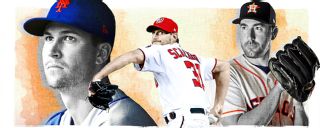|
Position-by-position tiers: C | 1B | 2B | SS | 3B | OF When you think about it, pitchers are kind of pre-sorted into tiers through the machinations of their managers and organizations. No. 1 starter, No. 2 starter, opener, bulk guy, LOOGY, closer, set-up man, multi-inning reliever -- these are all inherent parts of the pitching hierarchy in 21st-century baseball. What's murky about it, perhaps now more than ever, is what the relative value of a pitcher -- whatever his role may be -- is compared to an everyday position player. Increasingly, we also are starting to wonder how much current usage trends, with their deep bullpens, two-times-through-the-order restrictions, and on-and-off-the-disabled-list shuffling, have eaten into the starter's role as the king of the pitching kingdom. Make no mistake, though. The ace pitcher is not extinct, and while baseball's top pitchers may not carry the on-field value of preceding generations, they still carry plenty of value in both the marketplace and on the field. One hundred years ago, an elite starter like Walter Johnson likely needed to crack 10 WAR (Baseball-Reference.com flavor) to lead the majors, and he often did so. Johnson had seven seasons of at least 10 -- and as many as 15 -- bWAR. Such seasons have become increasingly rare. The only one we had between 2003 and 2007 was Zack Greinke's dominant 2009 campaign in Kansas City. But we had one last year, with Philadelphia's Aaron Nola reaching 10.5 bWAR. Now, WAR calculations for pitchers vary wildly between Baseball Reference and FanGraphs, which didn't rate Nola so highly, but there is no doubt that 2018 was a great year for ace pitchers. That it happened in the season when the Rays unleashed the "opener" on us was ironic and mysterious at the same time. Even in Tampa Bay, there are mixed signals. On one hand, the Rays contended with waves of mostly faceless relievers and only a fraction of an actual starting rotation. On the other hand, one of the Rays' bona fide starters, Blake Snell, authored the best pitching season in franchise history and won the American League Cy Young Award. Which direction is all this headed?
|

